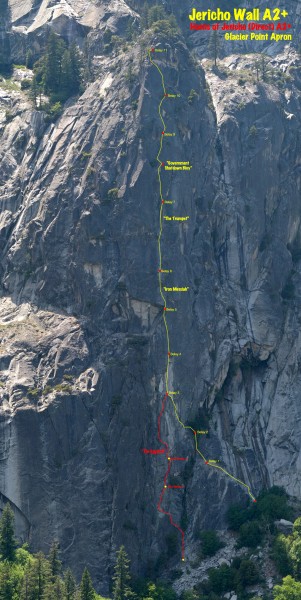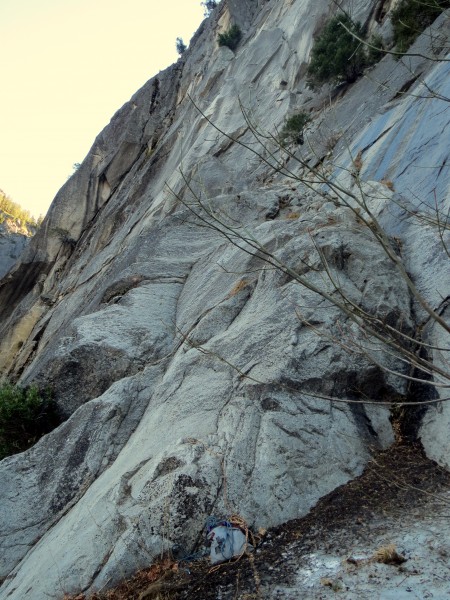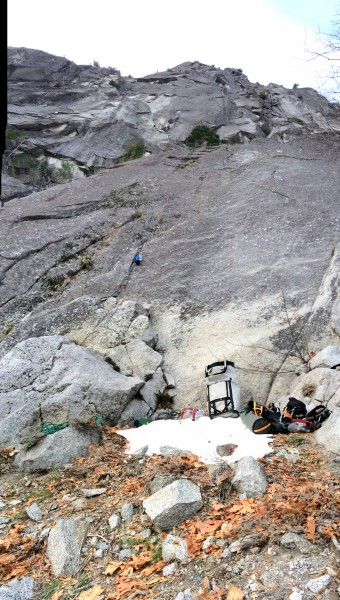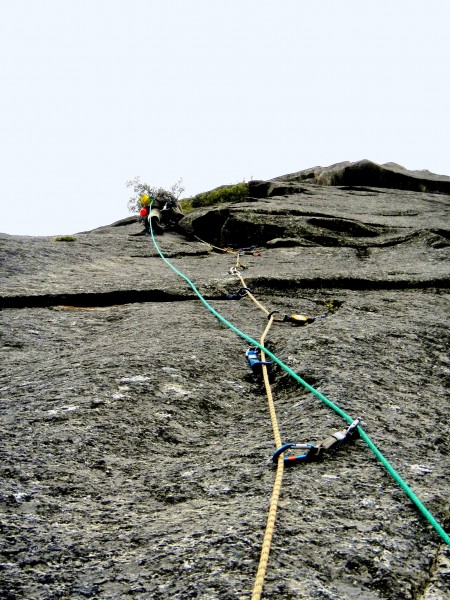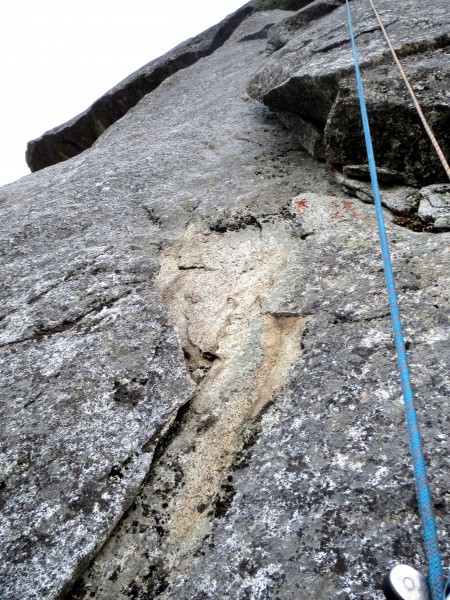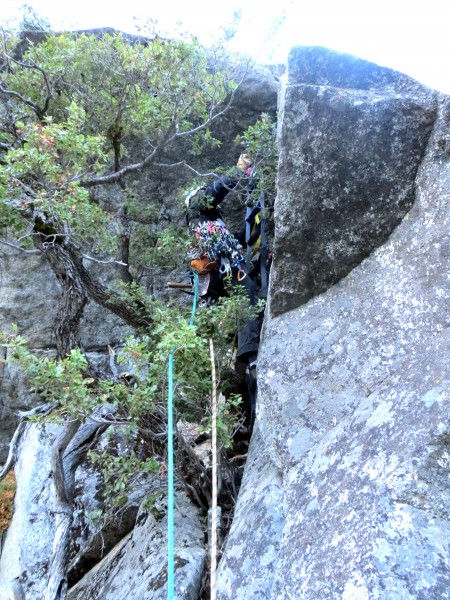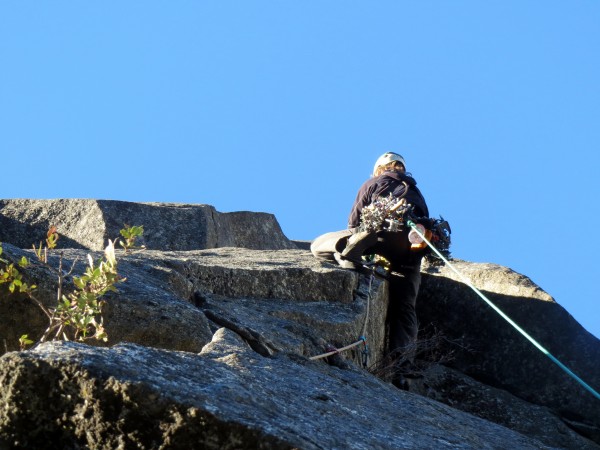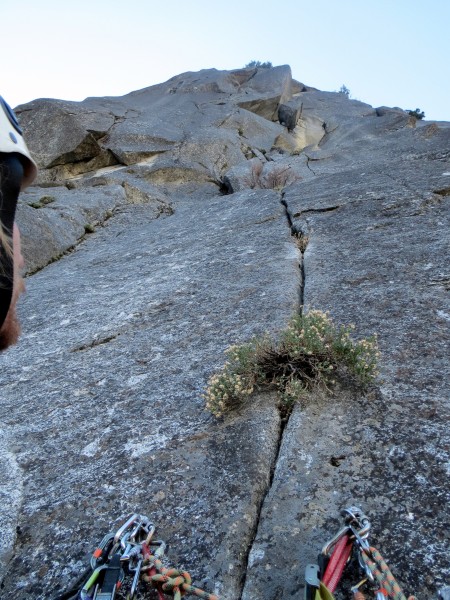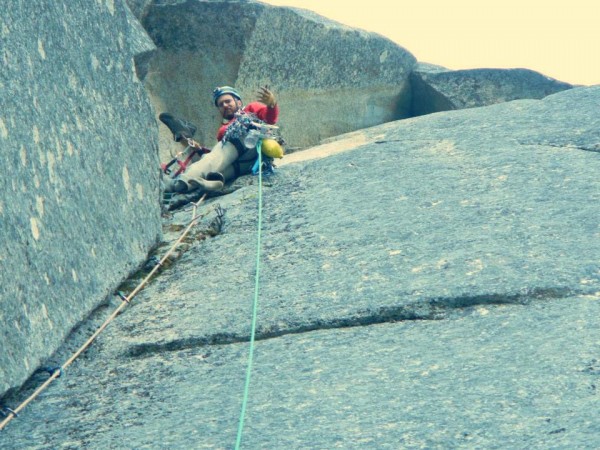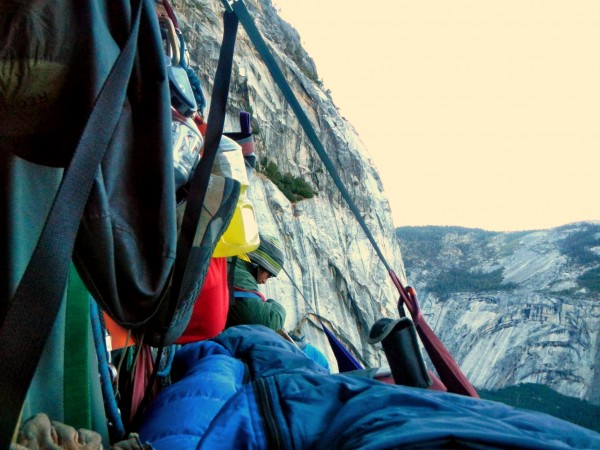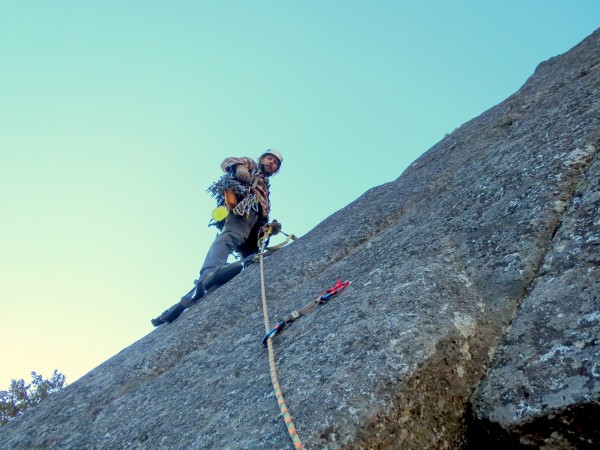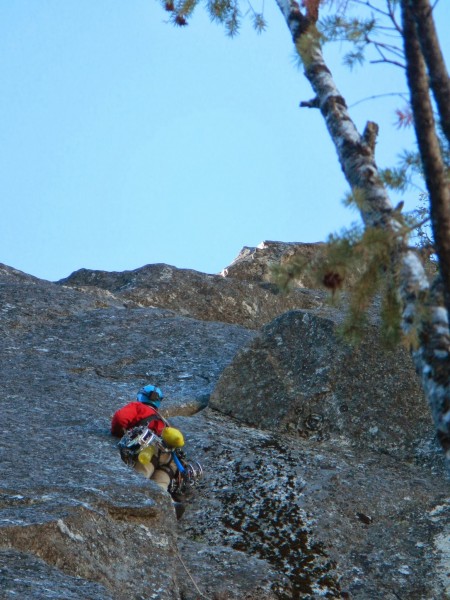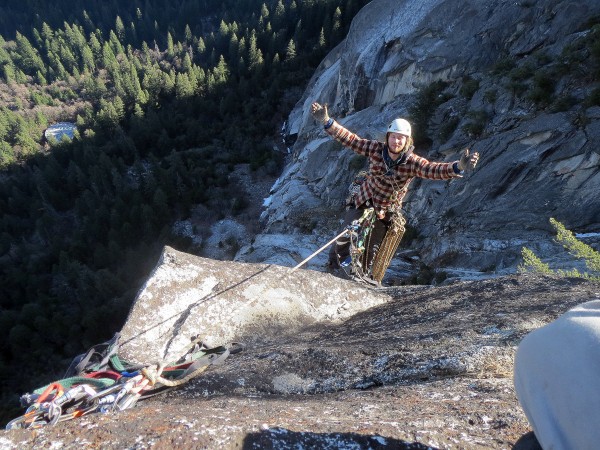For up to date topos of this route, go to http://yosemitebigwall.com/jericho
For more photos and trip reports and such, go to http://www.failfalling.com
Jericho Wall – Second Ascent
When the trumpets sounded, the army shouted, and at the sound of the trumpet, when the men gave a loud shout, the wall collapsed; so everyone charged straight in, and they took the city.
 Book of Joshua, Chapter 6, Verse 20
Book of Joshua, Chapter 6, Verse 20
Approach
We hit the parking lot of glacier point at 9am. The temperature was mirrored by the ice and snow still on the asphalt. I noticed that the cold air outside of the Diablo Rock Gym in Concord where we met that morning about five hours prior was much warmer than the freezing breeze that accompanied the Yosemite morning sunlight. I checked my bag to make sure that I had enough toe warmers to facilitate hours freezing in my pair of ladders and double-checked that I had extra pairs of gloves and beanies. My goal for this climb was to stay warm and avoid the popsicle-at-the-belay history that I had when doing walls with a partner in the winter. Just because this “winter” had been without snow and without rain, didn't mean it was warm by any stretch of the imagination. When comparing freezing to damn freezing, you always come out freezing.
History
We were in the valley to do the second ascent of Jericho Wall that had just been put up a couple of months prior by Josh Mucci and Steve Bosque. From the looks of the topo and talking to Mucci, it looked like the perfect miniwall for a team wanting to do a bit of thin nailing over a weekend; this was a moderate classic awaiting confirmation.
I’ve grown to love early ascents much more than the trade routes or even first ascents. Mucci tells stories of Chuck Clance teaching him to search for the early ascents “before they get all blown out.” With enough wall climbing, getting up the route becomes meaningless when compared to the experience inside each pitch on the route. Unlike trade routes, beaten into submission by multitudes of those who were overzealous with their nailing or cowardly with their chiseling and unneeded heading, the second ascent feels more pure. Unlike first ascents where you battle with yourself over how hard you’re willing to push it: A4 hooking can become A2 rivets whenever you want. On the second ascent, you have neither; you climb in ladder steps of the FA party or you bail. There’s a special place for second ascents in wall climbing. They require you to walk directly in the footsteps and sack of the first ascentionists.
Sometimes I think the reason I like second ascents is because it allows you to become another climber for a little bit, test your mettle against theirs. For all the mutual respect amongst my climbing wall partners, there’s always that voice in the back of your head saying, Are you able to hold your own as well as he/she did?
With a wall like Jericho put up by Josh Mucci (one of my wall heroes and friend) and Steve Bosque (one of my wall gods and dude-I-still-need-to-stop-from-freaking-out-when-I’m-around-him) I needed to know how I stacked up against my partners and friends.
The FA of the route was done over multiple months and the progress of the climb was marred by the smoke from the rim fire and the government shutdown preventing them from finishing when they wanted to. Mucci and Bosque had invited me to be part of the FA but our schedules didn’t quite match up, so I was itching to see what this route was all about. I got as much beta about loose death flakes and rope-cutting edges from Mucci and planned to get on this route as soon as I got finished with the rest of the routes on my solo-to-do-list.
Prelude
I was sitting in my apartment in Oakland preparing for a rope-solo ascent of a wall in the Valley when I noticed my friend Ryan posted on his Facebook pages, “Anyone want to go beer shopping with me in the Bay?” Ryan usually lives in Colorado and seeing him home meant only one thing. I sent him a message,
“Hey Ryan, let’s go do a wall in the Valley! 10 pitches, A2 nailing, and rap the route. Oh, and it’ll be the second ascent.” Always game, Ryan replied,
“SICK!!! I’ve been itching to get back on the granite. Only thing is I need to be back before New Years Eve for this party I bought tickets for.”
“No problem man, we’ll have a chill party wall, stereo, booze, plenty of sketchy belay-killer flakes, and be back in time to ring in the New Year. No better way to end the year!”
“YES!!! F*#k yea!”
Immediately scrapping my weeks of solo-wall planning, I pulled all of my notes on Jericho up on my laptop and began preparing for battle.
Still Approaching
After laying out our tarp and divvying up the weight for the approach, we had to choose between one massive approach with super heavy bags or multiple approaches. It's a short approach, I thought and so we loaded for bear. With the truck cleaned of foodstuffs and trash, we headed out, but not before I decided to test the viability of the parking lot as an ice skating rink. I was soon lying facedown with my haulbag attempting some sort of MMA grappling move on my back after slipping and falling with only Ryan’s laughter to soften the impact. "I hope that’s not a sign,” Ryan sputtered between laughter.
"I only believe in good signs, so no. not a sign."
The weight of my haul bag was similar to my bags when I aid-solo. We would learn after finishing the climb that we were bringing much more water than we would end up drinking. The approach weaves away from glacier point parking and meets up with the nature center before heading up a steep trail and finally uphill for the final leg to reach the base. Bigwalllesson#52 states that you should scout an approach before heading out with a full pack on, but I wasn’t in the mood for bigwall lessons. Too cold and too stoked for something like that. We stopped to rest twice before we even hit the nature center and that’s all flat hiking. I had a bad feeling about the uphill hiking that was to come, but at least neither of us was cold anymore. It was time for Bigwalllesson#84 "rest once your glasses fog up."
Once we found the bridge that marked the start of the uphill trail, we looked for the "two large boulders." Two large boulders were easy to find because there were many pairs of large boulders to choose from. After a bit we choose two seemingly at random and headed up the hill, thus starting our "here's the trail... no it’s not." bushwhack up the hill to reach the base (hint: there's a rotten log that has decomposed into the hillside making a wooden ramp that heads uphill. We thought that was definitely the way to go. Later approaches taught me that, no, you veer right at this point and continue up a well-defined trail from this point. Whoops)
With the weight of the pack, I was only able to go about 20-30' at a time before I needed to rest. Ryan had long since left me behind because he was obviously in much better shaper that I was. The final insult came towards the top of the hill when I had to ask Ryan to carry my bag the remainder of the way if he wanted us to start with any light left in the day. My role as "more experienced leader" was quickly being replaced with "whiney wimp." My only consolation was that Ryan was getting a sneak peek at my honed-to-perfection aid technique of whimpering and sobbing while on lead.
Pitch 1-2
The base of the route is a rather innocuous 5.easy ledge system, made all the more innocuous by Ryan's proclamation that he had already freesoloed up to the first belay while he was waiting for me. With the snow at the base and my constant desire not to freeclimb in wet approach shoes, I gave Ryan the first lead which we planned to link to the hanging belay at a tree that marked the 2nd belay. Ryan fifth classed the first two pitches easily with minimal protection. Before long, he was at the tree belay and calling off belay. I had wanted to be the gentleman and carry most of the rack for him to make the freeclimbing easy; after all, I'd be doing the pitches on toprope as a second after all. Within moments of starting up the pitch I realized that the traversing nature of the route combined with 2 pieces of protection for the 180' feet or so meant that I would def not be treating this as a simple toprope. More whimpering ensued. Bigwalllesson#162: Don't try to be a gentleman.
The first pitch went quickly with only a few friction moves in a groove between bits of snow to raise the stakes. I reached the first belay, a small bottoming seam with a fixed blade left in it. I was glad we would not be hauling to this belay station and quickly moved up and left to reach a dirt-chocked corner that would lead to more loose blocks and finally the hanging tree belay.
Instead of dealing with monkeying around the hanging belay, I decided to go up and over the tree to reach the side that pitch 3 would leave from. I clipped to the anchor cordelette on the tree trunk and untied from my rope to let Ryan pass it to the other side of the tree. At first I hoped he wouldn't be too critical of my breaking one of the cardinal rules of climbing until I looked over his belay setup and realized he was attached to the anchor with nothing more than a single quickdraw. I shook my head as I tied back in and offered a locking biner to Ryan so he could tie into the anchor with his rope. Bigwalllesson#43: Sport climbers are scary partners on a wall.
Pitch 3
We wanted to grab one more pitch before the light faded and so I set off on pitch 3. The topo called for "hooks and free" across a slab to reach the left leaning ramp that would be the rest of the pitch. From the belay tree, it didn't look as though there were many solid hooks along the path shown on the topo. I found it easier with climbing shoes to climb up from the belay tree, sling a branch on a smaller tree above it and then free along the top of the slab. No hooks required and relatively easy. I later found out that when the FA party went across that slab, it was running with water so your mileage may vary.
Once across the slab I placed a quick small cam and moved onto the ramp and found a larger detached block resting on the ramp and requiring a bit of balance to tiptoe around. After the block I got a good look at the rest of the pitch and my eyes lit up. A thin corner that looked like it would require a bit of beaking. I was not disappointed and made quick work of the pitch through beaks, cams and rivets. Towards the top of the pitch I decided to try to speed things up a bit by making some free moves to mantel onto the final ledge. There was a nice, arm-sized flake that would make a perfect hand and then foothold. Once I moved onto it though, it decided to proclaim its unworthiness by shifting and shaking in its resting slot. Quickly I came back down and decided to do one more move of aid before leaving the safety of my ladders. I reminded myself as I kept climbing that this was a second ascent and Bigwalllesson#185: On a second ascent, trust nothing.
Once I reached the belay ledge, strewn with many small loose rocks, I clipped the bolts and called off belay. From here, I could look up and see the entirety of the route as it soared above my head. Multiple corners and features that don’t always look like they can link loomed above me. I held my topo up next to the scene above me and had to trust the lines on the page that everything would come together as the altitude increased.
Fixing for the night
At the belay bolts, I took a quick breath and looked over the edge. We were considering running ropes from the 3rd pitch to the ground but the base of the route slanted ever downward the further left you moved along the base and I had no idea if we’d be able to reach the ground so we decided to fix lines from 3 to 2 and then to the ground from there. Ryan made quick work of cleaning the pitch and we were soon heading down as the sunset and darkness began to set in.
On the way back to the tree belay, I rapped past one of the rivets and noticed my rivet hangers still on the machine head. Such is the way of climbing with someone that doesn’t bigwall. I can list numerous partners over the years that have done the same thing, which makes sense considering the strangeness of the gear used on an aid climb versus a freeclimb. Much of the bigwall training comes with unlearning freeclimbing mantras. Carabiner on carabiner? That’s cool now. Always tie into the end of the rope? Not if you’re rope-soloing. Blank sections no longer always means run out freeclimbing; with ladders in tow, a blank sections now becomes search for holes and bits of metal in the rock with your fingers, cheeks pressed against the wall looking up into the light, or (more often) screaming “What the hell am I supposed to do!” until suddenly the footsteps carved with a drill appear. I yelled up at Ryan to remember to clean all rivet hangers. I recalled vividly an attempt on Zodiac with my girlfriend-at-the-time where upon needing rivet hangers, I called down for the rest of them only to find that she’d left them all attached to the rivets on lower pitches. Gladly, this time the teachable moment was caught early on and would not be an issue on this climb. Ryan may be new, but his head for systems and process of climbing a bigwall was quick and limber. A good sign for wall partner bliss.
I'm not sure why I was worried about reaching the ground from the 3rd belay but was so sure of reaching the ground from belay 2. I had assumed that the FA party had hauled to the tree because I couldn’t see them hauling off of the thin blade and beak belay at the end of the first pitch, and thus, a 200’ static would be guaranteed to reach, but not in this case. We rapped from the tree on the 200’ static line and I found myself at the end of my rope with 20' left before the ground. Unable to swing right for higher ground, I ended up attaching both of my ladders to the end of the rope, allowing us to reach a 4th class ledge we were able to easily downclimb.
When I described this process to Mucci, he laughed and informed me that they had fixed a line sideways along the ledge from the start to the 1st belay anchor and shuttled their gear. “Remember,” Mucci told me, “The first pitch of a climb is where you need to get inventive. Sometimes you need to swap ropes halfway through a pitch, sometimes you have to back clean for days, sometimes you have to shuttle gear.” The best part of a second ascent is that there’s seldom beta to be found from others as to what should be done. The ground that seems so comforting when you walk up to a climb is actually a two-faced double agent, giving the FA party to ability to get creative if they’re feeling frisky.
On the ground we ate our dinner and talked safety for a bit. The view was fantastic with Vernal falls in the shadows below Liberty Cap. I traced the lines of the Bosque/Mucci routes that I have wanted to do on the sunbathed formation if it wasn’t for the long approach. I pointed them out to Ryan and tried to quiet the barking dogs in my head that laughed at the idea of a guy that needed his partner to carry his pack the final leg of the approach, pointing out lines on a formation that may have well been on the very moon that would soon be lighting it.
In the morning we gathered our bags at the base and prepared to haul. Because the end of the rope was 20' up the wall, we doubled our tagline and used that to make up the difference. I had Ryan jug first and wait on the ledge below the tree belay so that he’d be able to transfer the haul bags from the tagline back to the end of the haul line once I’d hauled the bag to that point.
Once at the third belay (after a long and tangled lower out from the tree belay) we prepared for the next pitch. "It gets better after the 3rd pitch" was the phrase from the Mucci that I was counting on. The pitch looked clean and thin, the two required elements of a perfect pitch.
Pitch 4
I headed up the left corner of pitch 4 with easy C1 that leads towards a right-facing rooflet where I’ll need to penji around the middle corner to reach the rivets above. I reach the roof and am confronted with loose blocks and thin flakes. Here there is a rivet to avoid these features. Once I’m clipped to the rivet I pull myself around the corner to look at the beak seam I need to get into. I can swing around the corner but that looks like it’ll place me too low in the seam where the placements look sketchy at best. Not wanting to deal with that, I loosen my daisy and tension against the corner until I’m almost horizontal. A small hold on the arête allows me to place my foot for balance. From this position a place a marginal beak and ease onto it. I flick the beak a few times, a nervous tick I’ve developed when I’m on bodyweight-only pieces, and step up to place a much better red tomahawk that allows me to breath a sigh of relief and look down at Ryan having his dance party with the stereo on the ledge below me. I wonder why he’s not watching me before I realize that I forgot to call “watch me” before I moved around the corner off the rivet. Bigwalllesson#23 Don’t forget to communicate with your belayer.
After a few more easy placements, I came to the small rootlet where the rivets were supposed to be and my upward progress came to a grinding halt. I can see the rivets just before the belay, but no rivet that I can reach. I spent about 10 minutes sitting there and looking around for the missing rivet to no avail. Suddenly with my cheek pressed against the wall and looking directly up to the sky I saw the first rivet. "Found it!" I yelled down and leaned back on my fifi hook. Ryan replied by singing the next verse of the song on the stereo. I looked up at where the rivet was and to my horror, it was gone. Shaking my head, I looked some more and slowly was able to find it again as my face got closer to the rock. I held it in my eyes and leaned back and laughed as the rivet quickly disappeared again. I'm not sure if it was the time of day, or the lack of a full night's sleep, but this first rivet was harder to see than any other rivet I'd ever encountered. "There's witchcraft up here!" I yelled down. Ryan, who had been entertaining himself with arranging the rocks on the belay ledge yelled up,
"What!?!" to which I replied,
"Never mind, I found the rivet!"
I still needed to make a placement before I could reach it though so I placed a beak into the rotten crack of a detached pillar that led up from the rooflet where I'd taken up a 10-minute residence. Stepping up on the beak, I started to move for the rivet when all of the sudden I heard the sound of scraping and froze. Looking down, I realized that the beak had shifted and almost fallen out of the rotten crack and was now only hanging on by the slightest angle of only a 1/4' of the beak tip holding me from a fall that likely would have inverted me due to the way my foot was locked in place by my ladders underneath the rooflet.
There is a fantastic aspect to aid climbing where things become tenuous and life begins to move in slow motion. Breath ceases and all muscle movement becomes deliberate. You can never really appreciate it when it's happening, but after the fact, these are the times where you feel like you were able to overcome fear and act rather than lose your sh#t and give up. This is not to say the whining and lamb-to-the-slaughter bleating sounds were not coming out of me at high volume and pitch though. I called for Ryan to watch me and began to slowly look around for anything that would get me out of this predicament. No hooks, Too scared to walk down the ladder to my previous placement, I was able to place another beak above my now body-weight-maybe placement. Once I placed the next beak I was able to step up onto that and breath a bit easier. Rather than take out the first beak, I figured there wasn't a reason not to reset it considering how close to the anchors I was. Once I’d reset the first beak, I began to move up only to have the second beak now shift and slide down the decaying crack. "To hell with this" I though to myself in-between non-hardman whimpers and moved back to my first beak, second stepped it and made the rivet. Cigarettes are made for times like this but winter days are short and so I continued up to the belay without incident and clipped to the anchors with a sigh of relief.
Telling Mucci my horror story later, he let me know that he had lassoed the horn above the rotten seam where I’d placed my offending beaks. Aid climbing is nothing if not an embarrassment of riches where the currency is tricks and gear. Too often I find myself stuck in a single mode of climbing, beaks lead to beaks, heads lead to heads, C1 leads to more C1. This pitch had other things in mind and reminds me know about the dangers of ignoring all possibilities in pursuit of using the pieces clipped to the front of your rack.
Pitch 5
I'd spent enough time on pitch 4 that I was beginning to worry about finishing the next two pitches according to our plan. Remembering Mucci telling me that there was some real-live belay killers on this pitch, I stared up at the flakes 60’ above me and told Ryan to be ready for rain. It was then that I noticed the end of the rope hanging loosely from the belay. “Ryan! Why aren’t you tied in?” He pointed to his daisies and I stared at him. “Sport climbers” I muttered to myself before setting off onto the trail of rivets in the granite face.
The pitch starts with a small beak leading to rivets followed by a head of questionable longevity leading to a few more rivets until you reach the meat of the route. Flakes and loose blocks and (at the time) a massive ironing board sized flake that rung hollow. I looked down at Ryan directly below the flake and told him to keep an eye on things because he might need to get out of the way if things went south up here. Everything directly above me seemed suspicious and loose, hanging teeth waiting for the dentist to read them their last rites before yanking them out. Placing a suspicious nut behind a loose block on my right, I reach way out to my left to hook the flake to the left of the untouchable belay-killer. Once I gingerly negotiated my way around the loose flake and onto the huge Pika hook, I was able to topstep as the tip of the hook continuously settled deeper and deeper into a crack dividing the top of this flake. Reaching high, I got bomber cam in better rock and breathed a sigh of relief. As long as this piece held, it looked to be easy C1 sailing to the belay. I threw in another nut just below this piece for a bit of psychological pro and eased onto the cam. Just a touch of falling sand came from within the loose crack, always a perfect sign. I was home free and let out a quick whoop as I looked down at Ryan who was listening to dubstep on our stereo and gazing up at me and then out at the perfect view of Liberty Cap that this route offered. He let out a whoop twice the size of mine and started screaming out at the valley below, “I love bigwalling!!!!” Nothing makes you feel more secure than stoke.
At the belay I hauled all of our gear and waited for Ryan to make it up to me. Seeing Ryan approach the belay was a picture in frustration. His only other wall being West Face of Leaning Tower meant that rope management while cleaning was not something he had previously had to deal with. His long hanging rope beneath his backup knot twisted like spaghetti in the wind and seemed to search out every flake and edge below him like a cobra entranced by the movement of the snakecharmer’s flute. A quick primer on rope management while cleaning was in order and occurred at high volume to overcome the wind and distance between us. Ryan looked down at his ropes and stopped cleaning to reset and figure everything out. As he got closer to the belay, his ropes were under control and he was looking more and more like a wall vet with every push of the ascender up the rope. The metaphor of the situation was not lost on me.
I checked my watch over and over again and tried to figure out how much longer we had light. Winter climbing is weird because the days don’t feel long enough. On this wall, the sun disappears around midday and is out of sight so you start to try to gauge the angle of the shadows across Washington Column and Liberty Cap. This day had been overcast. The temperature was fine, but there was no direct sight of the sun all day, making the angle of the sun hard to see. When Ryan reached the belay he asked how much more light we had and I replied, “Don’t know, maybe an hour? An hour and an half?” We reracked all of our gear and Ryan prepared to set off on his lead. As he looked up at the pitch that follows a perfect crack that soars up and out of view, he asked again,
“How much light do we have?”
In the summer, there’s no need to worry about when the sun goes down. From a headlamp-sized cocoon, you just keep climbing until you reach your goal. The night can be cold, but never I-want-to-die cold. In the winter, the tables turn and the setting sun begins to feel like the countdown of a swinging pendulum in an Edgar Alan Poe poem. This belay hangs just 40’ above a huge ledge system that whispers “come, rest, sleep” over and over again. I looked at Ryan and said, “Party wall?” He responded by saying the only thing he really wanted was a real hanging portaledge bivy at some point on the route. Looking up at the Government Shutdown Bivy a day above us, I promised him he’d get his wish whether we kept going or stopped for the night. He turned and looked out at the views and hikers on the trails behind us and the ledge below us.
“PARTY WALL!!!” he bellowed, signaling that we were done for the day. We had plenty of time and no need to head off into the unknown when the known ledge was just a quick rap away.
Ryan made it down to the ledge and anchored the ropes in before I headed down while riding the pig. The angle of the rap places you right in front of the massive belay-killer flake before you need to tension over to the belay ledge. With the rappel locked off, I decided to see what a little wiggling would do. Waiting for my call of “Rock!” to finish echoing across the campsites on the valley floor below, I pushed the tip of the flake with my hand. Immediately, the entire body of the flake shifted, dropped a few inches and then began twisting off the wall and falling in massive pieces to the talus below. Part of me watched the granite carnage below while the other part of me focused on the many chunks of granite that slammed into the belay ledge where Ryan had been just an hour or so before. From his vantage point on the bivy ledge, Ryan whooped and commented on the size of the flake I’d just trundled.
“Party wall!” he shouted.
“Second ascents, Jesus.” I said to myself before swinging over to the ledge to bivy.
2nd Bivy
What our topo called “Bivy for 50” soon turned out to be sloping and without many good spots for flat and secure sleeping. Later the next morning, we would discover good spots lower down the sloping ledge that would have made for a much more comfortable bivy. But for this night, I found myself perched in a fetal position and being protected from sliding down the slope by a scrappy little bush and Ryan, moved to multiple spots before finding one that wove him, snakelike, through a Manzanita bush. The sun quickly set, washing the awesome view of Vernal falls, Nevada fall, and Liberty Cap with alpenglow. The sloping bivy ledge rests beneath a beautiful roof with a mini WDD crack splitting the top. For hours we played a new game Ryan invented called “What’s the backstory on those lights coming down the trail.” I countered with my own variation called “What’s that party on South Face of Washington Column doing?” Party wall indeed. We laid in our bivy and stared up at the snow above glacier point and the shadows of the cracks and slabs above us just out of our view. Before we fell asleep, Ryan showed me his prized headwear possession; a handmade fleece headband that looked like it came from the wardrobe of Aspen Extreme. “Handmade for YOSAR, this is my favorite headband.” I pulled my bland beanie over my face and fell asleep.
The calm night was abruptly disturbed around 1am when a fierce wind came up and kept me awake as I tried to find a way to stay warm in my bag without suffocating myself at the bottom. I cursed myself over and over for not checking to make sure that my winter bag was in the truck, thus leaving me with the 3 season Cat’s Meow, which was struggling against the wind chill. Thankfully I had brought my down booties that are a definite must for any winter-esque bigwall outing.
Pitch 6
In the morning we took our time, enjoying the view for a bit before packing up and making the short return trip to the 5th belay. This was to be Ryan’s first aid lead and his stoke level was high. “Party Wall!” echoed down to the hikers on the mist trail as he prepared himself at the belay. I popped Tom Petty onto the stereo and sent him on his way, hauling while he worked his way through a tree and then up to the awkward roof/corner just off the belay that would lead him into 150’ of C1 splitter glory.
When I first got the topo, I noticed the pitch called “Iron Messiah” but rated C1. Intrigued, I asked Mucci about it and got to hear the story of how the pitch got its name. Mucci told me that the entire time they were scoping the route, looking at telephoto images from various vantage points, they could barely see a line that would connect to the corner system above the belay. He assumed from this information that it would be a pitch of heads and beaks and rivets to connect the features. When he went up and met the pitch face-to-face, imagine his surprise when he turned the roof and was faced with a splitter thin crack that would go completely clean. In Mucci’s story, he first sees this crack and looked down at his rack that was all heads and iron and only a few cams and knew that he’d be sending his entire rack back to the belay in order to pull up a completely new rack. This turned the chosen name for the pitch on its side but still allowed it to fit. What was originally a name to describe the pitch had become a name that jokingly poked fun at the notion that a climb can always be figured out from the safety of the ground.
Ryan was in a similar position I realized. Though he had the topo in hand and knew what to expect, his lack of aid climbing experience meant that he was going into the pitch legally blind. Just as Mucci would discover the difference between what he saw and what he climbed, Ryan would soon discover the difference between the conceptual information found in lines on a topo and the real experience that can only be found on the sharp end.
After Ryan had passed the corner his rope stopped suddenly. Upon examination, we found that the rope was wedging itself into the notch at the top of the roof/corner that Ryan had just overcome. “I need something to shove in this crack…” he said to no one in particular before grabbing at his helmet while saying he had an idea. Soon, his 1980’s headband was shoved into the crack beneath a cam and he was off into the great C1 unknown.
I was able to follow his progress for half of the pitch as he went to work dealing with the thin splitter that was sucking up his smaller pieces early. “Have you used a camhook yet?” I yelled up at him while Tom Petty continued playing around me.
“No camhooks yet.” He yelled back down as he started fiddling with another micronut.
“Use camhooks”
“I’ve never used a camhook”
“Find vertical crack, insert camhook like the minute hand at 3 o’clock, clip into camhook, stand on camhook.”
“Ok.”
And soon Ryan was out of sight. I spent my time singing along with Tom Petty and watching the tourists stop at the first turnout on the mist trail. I waved from time to time but they were too far away to tell if anyone was waving back. As the rope moved slowly through my grigri I played a game called the-sun-is-on-me-take-off-my-puffy-now-the-sun-is-off-me-put-on-my-puffy. Time dragged to a standstill and I began to remember why I like bigwall soloing so much, with its never-ending movement and all-encompassing focus. More importantly, when soloing bigwalls in the winter, the best part of the system is the warmth and lack of boredom that comes from always moving and never having to wait for your partner unless you’re waiting on yourself.
After a few hours, Ryan called down “5 minutes!” and I gathered my things and prepared to see this pitch he’d just finished. After 20 minutes, I made a point to talk to Ryan at the belay about misjudging the amount of time it takes to make those final moves to the anchor when your entire rack is plugged into the rock beneath you. This is something I still have trouble with on the wall, summit/belay fever always convincing me that the final 10’-20’ to the belay will be a cakewalk compared to everything that came before.
For his first aid lead, I was impressed. Very small nuts placed in interesting placements, small cams that didn’t fit but were good enough for bodyweight, Ryan had transitioned from sport climber to aid climber in the parts of the pitch that only fit the pieces placed far below. I noticed that the first part of the pitch would accept camhooks perfectly and decided to rename the pitch “Camhook Jesus”
At the belay, I gave Ryan a high five along with his headband and congratulated him on crushing his first aid lead ever. I couldn’t think of a better pitch to do it on, with just a small bit of awkward in the beginning to earn it, followed by smooth splitter sailing. “How many camhooks did you use?” I was thinking of the 1-2’ between each placement for much of the pitch.
“No camhooks.”
“Use camhooks”
“Ok.”
The Pitch 6 belay is perfectly setup for two portaledges, with the 3/8th bolts centered on the ledge for the bags and rivets off to the left and right. I was beginning to wish that we’d continued on climbing into the dark to reach this belay, as we’d probably have gotten a better night’s sleep.
Pitch 7
Before starting the pitch, I tried starting up the stereo with some tunes to climb to and realized the ipod had turned itself off and refused to turn on again. “No more tunes man” I said to Ryan and was secretly glad that I wouldn’t have to belay too many more pitches without tunes to keep my mind off the boredom. “I’ll try to make this next pitch quick.”
The next pitch went quickly, with finger and hand-sized C1 allowing for easy topstepping. I would assume that the first part of this pitch would go at 5.9/5.10 but wasn’t in the mood to find out; we had two more pitches to make it to our bivy and speed was now the name of the game. In the middle of the pitch is a nice detached mini-fridge-sized block that I placed a cam against to yard on but then took the cam out once I was standing on top of it. I didn’t want Ryan to weight the cam when he came up to clean the pitch since this block held its place just over the belay.
After the sharp block, the crack turns into a larger right leaning slightly flared bit of grunting happiness that ended with a bit of wide and a #5 cam placed into a groove to help me gain the sloping ledge where the belay is. I had originally intended to link pitch 7 and 8 with our 70m rope but took one look at the wide corner I was going to have to grovel into and my larger pieces left behind in the crack below me, I set my anchor at the bolts and decided to do the pitches separately.
Pitch 8
The next pitch started easily with a quick mantel onto a higher part of the block ledge system. Within moments, my foot kicked a bit of rock that suddenly came loose and started to fall. Moving without thinking, I was able to cup the shoe sized rock under my shoe and held it there while Ryan moved up from the belay to grab it and chuck it off to the side. “Bad sign?” Ryan asked.
“I only believe in good signs.”
Soon I was in the C2 flared wide of the pitch, which was straightforward though interesting. At the top of this crack I stepped out of my aiders and got a foot jam in order to get a solid placement above the less-reliable placements in reach of the ladder. Resting on the piece after placing it, I realized that I couldn’t move my foot. It had shifted a bit while I was standing on it and wedged itself deep into the crack. I felt like Honnold in the video of him trying to onsight of Belly Full Of Bad Berries (probably the last time I’ll ever feel like Honnold). I called down to Ryan and told him my predicament. He replied with a hearty “Party Wall!” shout and I shook my head while smiling. I ended up having to take my foot out of my shoe while hanging from my daisies into order to decrease the volume in it enough to twist is back out of the crack. Taking out his camera, Ryan yelled up at me,
“That’s definitely a good sign!”
After the wide section, the corner slams shut into a perfect beak corner crack that leads to the hanging belay. Fun and easy nailing for about 20’. In no time, I was at the belay clipping the bolts and starting the haul. Ryan took off to clean the pitch and I relaxed on the haul bag once it reached the belay. We’d made good time for a party wall pace.
Third Bivy
The Government Shutdown Bivy is nothing short of stellar. Hanging out beneath a large roof, protected from the elements but with an amazing view of the valley below. Two fat bolts for the belay and a 1/4" split shaft out to the right for the second portaledge, it's setup perfectly for a chill evening hanging out on your ledge, drinking and watching the specks of headlamps on Half Dome, Washington Column, and coming down the trails.
At the belay, I took the 1/4 bolt out right from the belay to hang my ledge from and gave Ryan the 3/8 bolt on the belay to hang his ledge from. "So, how do you setup a ledge?" Ryan asked.
"You haven't setup a ledge before?” I let out a quick laugh, “Well luckily, the A5 singles are the easiest to setup because this here's a hanging belay and setting up a ledge from a hanging belay is one of the harder things to do without practice." We both looked at the changing light on the face of Liberty Cap and realized that we didn't have that much time before setting the ledge from a hanging belay would change to setting up the ledge from a hanging belay in the dark.
I walked Ryan through the process of setting up my ledge and then sat down to settle in for the night as his battle began. My own ledge was attached to the single 1/4" bolt with my climbing rope anchored from that bolt to the main anchor. For the rest of the night, I would take a moment every now and then to calculate the 2-3 feet everything would fall and swing to should the bolt fail.
Out came my normal wall meal of a stick of salami, dried mangoes, and mint cookies. For his first time ever, Ryan got his ledge setup quickly. I was noticing that the most prevalent feature of his character on the wall was that he was a quick study. Walls are always more of a party when your partner either knows what they're doing, or figures it out quickly. Ryan pulled out his canned food and went to town while we talked safety and the next day's plans.
According to the topo we had, we would be able to rap with a single 60m rope all the way from the top back to the shutdown bivy. From this info we decided that the next day we would leave the bivy setup and just take our 70m lead rope to reach the summit. With no hauling or second rope to deal with, we hoped that the day would go quicker. I decided that we didn't even have a need for the tag line either because I would just climb with the full rack on me (something I've become used to due to the amount of soloing I'd been doing and the irritation that comes with trying to run a solo-tag rack), further lightening the load.
The nighttime dark quickly overcame our headlamps and the lights sweeping like a windshield wiper across the face of Washington Column from Dinner Ledge, stopped and settled in for the night. The people wandering down the mist and muir trail slowed to a trickle, and eventually the valley floor went dark except for the reflection of the starlight and then, the moonlight off of the low hanging fog of campfire smoke which was itself blown away by the rising wind that began to blow around the corner that protected our bivy. Ryan’s spot was wind free, but I was able to burrow down into the bag with only my thoughts of the impending drop that would happen in the night should my chosen single 1/4'” anchor point fail to keep a shiver going up and down my spine.
In the morning, I noticed a perfect arrow placement just above the bolt that would back it up nicely. Beta for the next party since my own night was spent arrow-backup free. We woke up slowly, Ryan relishing his first morning at a proper hanging portaledge bivy. “Hey, can you get a picture of me chilling in my ledge?” I laughed for a second at him before abruptly stopping.
“Your picture will need to wait, hand my the sh#t bag, now!” My body has a habit of being unpredictable when it comes to dealing with waste. 4 Days on Zodiac and 6 days on Afroman both without ever needing to use the wag bag. On this wall though, I had gone from being completely fine to being given a vision of a massive countdown clock that let me know that I had about 1-3 minutes max before there was going to be a serious waste removal issue on my ledge.
Ryan laughed until he saw the look in my eyes, then he quickly got the wag bag for me and I went about doing my business not unlike a person trying to walk across hot coals. “Now, you’ve had a proper hanging portaledge bivy” I said as I placed the wag bag off to the side and started taking pictures of Ryan chilling in his ledge.
Pitch 9
From the bivy, obvious rivets lead up and left over the corner. This was to be Ryan’s pitch. Remembering below when he had said that a nice rivet ladder was his dream, I pointed to the first rivet, collared with a bit of red tie-off webbing, “Here’s your rivet ladder dream.” The rivet was reachable from the leftmost bolt on the belay but I could see that you could easily place a pin in the lip of the roof to reach out to the rivet, but I decided that Ryan was going to have to earn this pitch.
“Clip, ladder, step up, reach, clip, and go.” Was my response when Ryan asked how he was supposed to reach the rivet. Ryan looked at me with a questioning gaze.
“You can do it, and if you can’t, I can” was my response. I knew he could do it, being many inches taller than me, and knew that this would be his last bit of aid climbing on the route since the rest of the pitch would be primarily freeclimbing around loose choss.
Ryan stepped up and made the clip after a few aborted attempts and was soon out of sight and moving steadily up. Once again, the metaphor was not lost upon me. I could hear bit of rock and dirt moving steadily down as he did so, but all out of sight. Soon enough, Ryan had finished the pitch and I stepped into my ascenders to clean the pitch. At this point the angle of the route kicks back, allowing for a lot of freeclimbing possibilities and long reaches when in the ladders.
Once I passed the rivet ladder on my jugs, I got a look at the chossy bowling alley that Ryan had just climbed through. On the topo, it called for freeclimbing and a few points of C1 aid. Ryan had freeclimbed through the loose blocky ramp without breaking a sweat. Kicking a few more rocks loose as I cleaned his pieces, I reminded myself to never underestimate stoke.
Pitch 10
At the belay, we quickly reracked while I looked at the pitch above me. The route goes out right for a small section of thin and dirt before moving left into the main crack. Not liking what I was seeing, I noticed another line that heads out left and looked like it would easily connect with the main crack via a easy looking slab traverse. “Thinking of changing the topo?” Ryan asked and I took one last look at the unknown slab traverse and then down at my approach shoes,
“If I come up here again, I’ll try it, but right now, let’s just gun for the top via the topo.”
To the shouts of “Party Wall” I moved around the sad and dying tree that was part of the belay and started to do a bit of cleaning in the crack with my nut tool. After a few moves, the topo shows a pendulum that is actually a static reach from one crack to another. I used a micro-camhook as my highest piece and reached out horizontally to make the next piece. Once established in the new crack, I gave the camhook a quick flick and watched as the rope ran smoothly from my previous piece to the new pieces I was on. I have trouble with rope drag from time to time because I’m so used to rope-soloing where rope drag is never a problem. “See that? Good sign.” Ryan nodded and I camhooked and beaked a few moves before reaching the mungey C1 arch that would take me up and too the belay. After turning the corner of the arch, I was back in dirt and choss for an easy ramp that went free except for a few point of aid to clean the dirt that was tumbling down like sand.
Neither Ryan nor I had a watch and the overcast sky was making it hard to know how much time we had. I assumed it was midday, maybe afternoon, or perhaps midmorning. Under the winter sky, any answer could have been true. Regardless of the time, I moved forward against the tide of dirt and made the belay. A slung tree with an angle to back it up, this would not be the best belay spot if one was hauling to the top, but I settled in, called off belay, and waited for Ryan to clean the pitch.
Pitch 11
While waiting, I took out the topo and looked at the next pitch. The final pitch has some rivets leading to freeclimbing followed by hooks and then a bit of rivets and then freeclimbing to the top. I reached to the back of my harness to prepare my hooks came up with a handful of nothing. A quick and desperate search of the rest of my rack and harness yielded no hooks as well. “Hey Ryan! You got the hooks on you?”
“No hooks dude, why, do you need them?”
“Hope not!”
“Only good signs dude!” Unable to see the portion of the pitch above me that had the hooks, I hoped I’d be able to make something fly with my beaks as hooks depending upon the nature of the hooking.
Soon, Ryan hit the belay and I was off to taste that sweet summit glory. I figured that I’d need it after the sour taste of hooking without hooks I was expecting. The belay I’d chosen was setup so that I’d have to traverse out right around the tree and make a few free moves onto a bivyable ledge with a tree. From there, a few rivets to avoid the rotten rock in the crack and I was face to face with the hooking section. Looking for the rivet that would end the hooking section, I once again couldn’t find it. About to curse the route for its stealth abilities with rivets, I suddenly saw the rivet. It had initially been invisible because I was looking too far ahead of me. On the sloping slab where I was, the rivet was only a few feet away. I looked down again at my approach shoes and shrugged before setting off on a short odyssey of 5.7ish slab moves to reach the rivet. Once I clipped my ladders to the rivet I let out an exhale of relief. I knew I was counting chickens before they hatched, but in my head, this was the final hurdle that made me worry about whether we’d be able to reach the summit of this route. The rest of the pitch was uneventful free climbing with a touch of rope drag.
The summit bolts are drilled on the face of the summit with a small little ledge to access them. I ended up climbing around the back left side of the summit block and couldn’t find the bolts at first until I looked down and realized that I was standing directly above them. A quick clip and drop down onto the ledge and I let out a whoop while all the proverbial eggs hatched. I yelled for Ryan to get up here and started to explore around the summit of the route. Jericho Wall goes to its own independent summit with plenty of room on top to stand with your partner and yell “Party Wall” until it echoes back at you from the myriad of iconic crags dotting the sweeping panorama
Descent
Once Ryan hit the bolts, we wandered around for a bit. I found a cairn left behind by the FA party and added a rock or two to it. After a short while we setup the rap and I went down to reach the next belay station. At the very end of the 70m lead rope I realized, this single rope rap was not going to make it to the belay station. It was barely long enough to reach the tree ledge just above the station on the sloping corner. I called up to Ryan to let him know the situation and came off the rope onto the ledge. The downclimb from the ledge to the belay station wasn’t too bad and after we pulled the ropes, I made it to the belay and reset the rap. Our grand plan of taking only one rope now seemed like it could be an epic in the making, but at this point getting down was the goal and if I had to leave an intermediate rap station with gear, so be it.
When I talked to Mucci about the belays later on I realized that I had misjudged their rap anchor for the pitch belay anchor. On the original ascent, they had climbed the 10th pitch all the way to the treed ledge rather than the sloping belay I’d stopped at with the tree and angle setup with fixed cordalette. This made a lot more sense than where I stopped and would make for a more comfortable belay and would also allow a party to descend from the top back to the Government Shutdown Bivy with a single 70m rope as we did. With only a 60m rope, future parties will need a second rope for the first rap.
The next two raps went fine though with the last rap into the Government Shutdown Bivy swinging in from the opposite side of the bivy from where the next pitch went out on rivets. The steepness of this side was fantastic allowing you to see all the way down the wall and needing to swing and then pull yourself into the belay. I setup shop at my portaledge and took out my phone while Ryan made it to the bivy.
We had decided that if we got back to the bivy before 4:00 then we would head down. Looking at the gray overcast sky, I had no idea what time it was. As the phone powered on, Ryan was approaching the bivy. As he got there the time popped up on my phone: 1:45pm. “Hey Ryan! Looks like we dine in civilization tonight!” He clipped in, let out a whoop and we started to break down the bivy. Soon enough, I started loading things into the haul bag when I noticed my chalk bag that holds my hooks clipped to the straps and hanging impotently in the wind.
“Found the hooks!”
“Good thing you didn’t need them”
“Party wall?”
“Party Wall!”
According to the topo (which I no longer trusted for rope lengths – such is the joy of the second ascent where you get to correct minor mistakes that can become major if you’re not careful) we had double rope raps all the way to the base. Our first rap would skip the 7th belay station and would be a plum line straight to the 6th belay. Ryan headed down with the gear first and I would follow with everything else. I figured that this being Ryan’s second wall, I would be a gentleman and not force him to deal with the irritation of riding the pig and ledges. In retrospect, this decision helped immensely once the issues with rapping continued. Bigwalllesson#162: Be a gentleman. We setup the ropes to do a reepschnur (biner block) so we could use our grigris to rap. 20’ from the 6th belay station Ryan ran out of rope on the 200’ static line and sat there hanging above the belay while we figured out what to do. I suggested that he jug back up the the 7th belay and we’d just do two shorter raps instead of one but Ryan decided that he could transfer to the 70m lead line and connect the end of the lead line to the haul line allowing us to still pull the rope. “Genius!” I yelled down at him and he set up the system and finished the rap.
Up at the belay I realized that I had another problem to deal with. I had setup the anchor underneath the chain links that we were using the rap from effectively trapping the anchor biners. With the haulbag weighting the anchor I had no way of retrieving the anchor biners since once I transferred the haulbag to the rap line, the biners would again be trapped beneath the combined weight of the rope, the haulbag, and myself. To add insult to injury, all of my gear and webbing was down at the lower belay with Ryan. I made the decision to leave the anchor setting in place and leave it as booty for the next party, so to the next party that heads up this wall, there’s a nice Yates bigwall rabbit runner with two biners up for grabs.
Once I reached the 6th belay station, I anchored the pig and started to pull the ropes. They moved a bit before getting jammed on something. Pulling out my ascenders, I began to really put my back into it until a quick “pop” occurred and I was leaning backwards against a tight daisy anchored to the belay. “What happened?” I asked as Ryan sheepishly showed me the knot protector that was still attached to the end of the lead line.
“I saw a biner and figured that was good for attachment to the rope.” My knot protector (an orange oil funnel from the autoparts store) was anchored to the end of the haul line by a knot jammed in its spout and a biner attached to a bit of utility cord attached through the plastic at the base of the funnel. This bit of plastic had finally given up the ghost and snapped off. I shook my head at Ryan while waiting for my heart rate to return to normal and went up to retrieve the end of the line and finish the pull. Bigwalllesson#13 Double check your partner’s work.
The rest of the raps were uneventful until the double rope rap from the 4th belay to the 2nd belay. This rap requires you to veer far left to hit the sloping tree belay. Easy enough for Ryan carrying the gear, but a bit more difficult while riding the pig. We had to work together to have him pull me into the belay once I’d lowered enough. The long sideways pull ended up having the rope jam when the kinked roped started to wrap around itself at the belay. I ended up having to ascend the rope to sort things out before we could make the last rap. By now, the day was starting to fade and I was glad we hadn’t started to descend around the 4pm mark that we’d thought would be enough time before getting back to the Government Shutdown Bivy from the top earlier in the day.
From the tree, it was an easy rap on the 70m lead line with the same tie-the-end-of-the-lead-cord-to-the-static-line method that Ryan had come up with on the earlier rap. Once we were both on the ground, we looked up at the climb and let out a few more whoops. While discussing safety and pulling the ropes, I looked over at the buttress leading from the ground directly up to the 3rd belay. “This route would be so much cleaner if there was a direct line leading up that part of the wall. Then you get more aid and easier hauling and descending.” Ryan nodded as he sorted through the gear,
“Who’s going to put a direct variation up though?” I took as many pictures of the face as I could in the waning daylight.
“Probably would go at A2/A3, and probably wouldn’t change the character of the climbing at all and then teams coming up for a fun easy nailing route wouldn’t have to deal with all of the strangeness of the lower pitches.” At this point I was distracted by the 2.5 gallons of water we had left over that I dumped out on the ground to save weight for the descent.
“Well, an FA of the direct line will have to be something for someone to do next year. Let’s get home so I can get ready for my New Years Party.”
We sent one final echoing call across the valley and wrestled the pigs onto our backs and started to head down the path to the truck and back to the Bay Area.
With the weight of the pig back on my back and trudging through the forest in the dark after we lost the trail within moments, I reflected on the route. Minus the approach pitches, every pitch had fun climbing that made you think for a bit on it with standout pitches being pitches 3, 6, 7, and 8.

